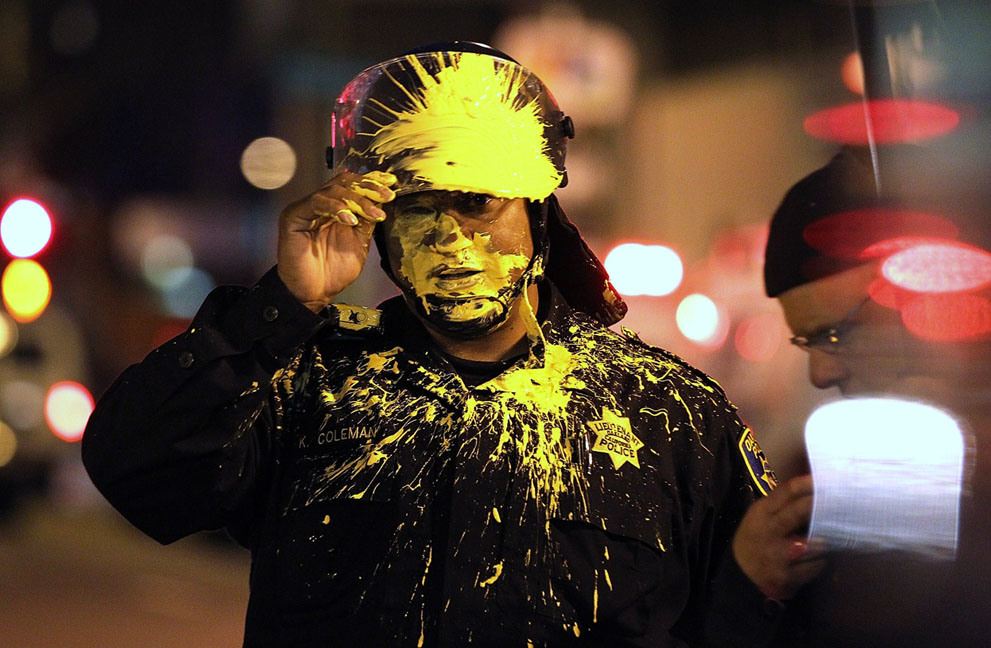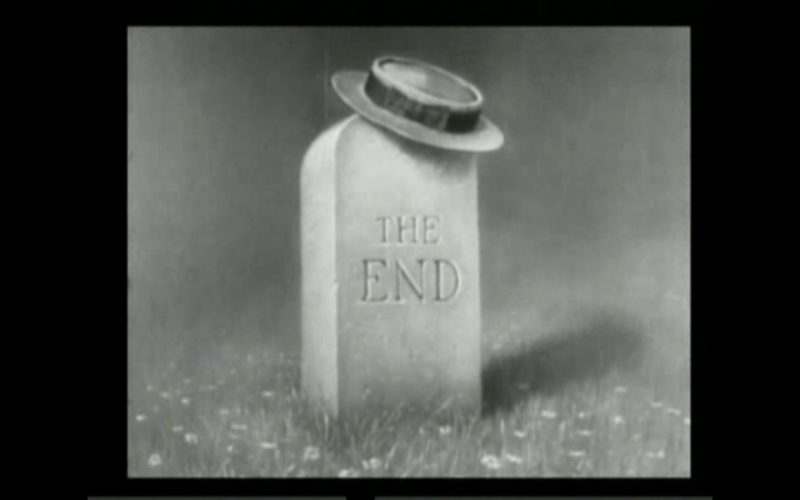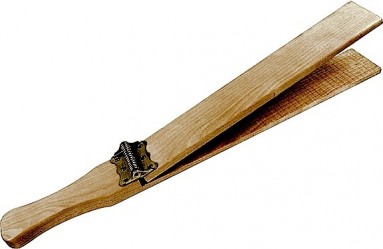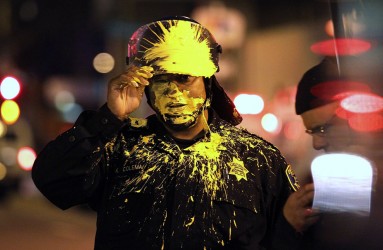[this is the first part/lead in to the essay published in the TNI Cops issue, an essay that began as a talk. (Hence a certain chattiness.) At the start, I give a brief restatement of my previous work on hostile objects, through the specific lens of Keaton, before digging into one of the best anti-cop films ever made, Keaton's Cops (1922).]
[from Keaton's 1928 Steamboat Bill, Jr.]
What strikes me, every time I watch this, is that sudden, wrenching perspectival shift, the falling away of a fantasy - the world is made for us, by us, in our image, and will function in accordance with the aims we give it – through the fall of a life preserver ring that sinks like a stone. There have been, previously in the film, hints toward a cussed obstinacy of the material landscape, such as a set of hats, none of which are acceptable to both father and son, and which, when narrowed down to one workable hat, is snatched away by the wind. But with that, there remains the sense of minor, invigorating inconveniences: how else do you develop a bit of gumption and character without tussling with the resistant order of things? One learns, so to speak, to hold onto his hat and to brave the world.
This is entirely different. It is different because the life preserver does not, for example, get blown away. Or stay stuck to the wall, or catch on fire, or even just prove to be of soggy little help to a drowning swimmer. Rather it fails - spectacularly - to perform its specific function and does precisely the opposite. It is a life terminator ring: not neutral crappy or broken but a murder weapon, a sabotage of the sole use-value it has. It is, in short, one type of what I've called a hostile object: an object which should help us make our way through the world – that should meaning “designed, planned, and fabricated in accordance with the dual logic of exchange and use value” - yet which in fact makes that world far more dangerous and intolerable. It should be commensurate to the structures of intellection of the social order that brought it into existence, yet it is unpredictably dark to that.
The wider theoretical framework on my thinking on hostile objects can be sketched roughly as four points.
1. We live inside a built record of hatred, antagonism, anxiety and frustration, all concretely poured into millions of hours of time and transformed material. Those objects are produced in spite, despair, and irrelevance, and they are therefore a record of it. We are not unaware of this: it has terrible effects on us. Yet it tends to show itself in an uncritically animist conception, in the investment of phantom subjectivity: some thing is out to get you. Or in the fact that, even without markers of volition, the species produces its own doom in highly local forms enacted on individual bodies and minds: nuclear waste, cars, cigarettes, cars, lead paint, automata dolls that chew fake food but cannot distinguish food from the hair of 5 year old girls, the prison system, tainted food, etc. Part of the task of slapstick, however, is to broaden the field of what can show itself in this way, chaining them together into a reeling nightmare of bad placement and bad timing.
But the particular nature of this, even extended to seemingly “nice” objects like a cake, is just the most literal form of material hostility, and it ultimately misses the point. For - to take a set of examples from Italian communist theory - if we take seriously the non-neutrality of productive assemblages (Panzieri), the structural and primary position of worker’s antagonism at the heart of the development of capital (Tronti), the impossibility of drawing a coherent line, in terms of the site of the production of value, between waged production and unwaged reproduction (Federici and Dalla Costa), the admixture of living and dead labor (late Bordiga), and if we take seriously that labor is a coercive process of the exploitation of the particular under the sign of the general, one that requires the violent paid and unpaid exploitation of humans and resources in the service of the construction and circulation of commodities, it follows that the entire built world of capital – buildings, furniture, highways, silverware, computers, wiring, painting, magazines, medicine, web pages, bullets, human bodies - is composed of actual, not metaphorical, crystallizations of congealed labor and, therefore, congealed hostility.
2. As such, it is not specifically bound to specific hostile objects. Nor is it bound to physical breakdown or “things behaving badly,”, although it makes it more comic. However, it does primarily show itself in that way, only appearing in moments of breakdown, of comic ruination.
3. The particular form of this is sabotage. Sabotage, properly speaking, does not mean an attack on production or circulation. That comes from a juridical and military capture that emerges as a concrete response (and intentional misreading) to Western European syndicalism and the Wobblies in the U.S.. Rather, sabotage's specificity is the failure of a process in terms of the specific qualities of that process. For instance, this can involve over-adulteration (ruining a commodity by adding a bit too much of the chemicals already added to adulterate that commodity, thereby revealing it as already toxic and unusable), of following the rules too well (going slow by means of checking every safety procedure), of attacking the vaunted quality of a product by turning it against itself (the specific quality of perishable food items is their perishability, their capacity to rot; blocking their circulation makes this desirable quality – positively called freshness – into the means of their ruination), or of inverting the required quality (labor-power is only productive for capital when it is sold across time; a strike is simply the taking of labor-power out of time, such that it becomes idle). In every case, the obstinate particularity of things is made to fail such that they can no longer be abstractly valued. Sabotage is the attack on the general by the self-destruction of the function of the particular. A city is sabotaged by barricading it: bringing the city to bear against itself to the point that it cannot function. It is an attack on laws of abstraction which make the particular lives subsumed by them untenable. Ww wreck the polis by means of all that makes up this city but which is disavowed beneath the fantasy of the cosmopolis.
4. These other qualities of the particular only emerge in the process and aftermath of its being ruined, either in terms of the commensurable (it can’t be exchanged) or when its own function is broken (present-at-hand). For me, however, the difference from Heidegger's conception is that a busted hammer doesn’t reveal its hammerness, doesn’t become visible as such. It reveals a set of qualities that enable it to be used otherwise, its non-hammerness. This is the logic of salvage I have stressed elsewhere, the bound twin of sabotage.
Comedy is the main site of the elaboration of this. In part because it involves objects that don’t function like they are supposed to, in larger part because it is willing, in order to gain a laugh, to gesture toward the enormous crystallization of wasted labor and negative affects poured into the objects of everyday life. Moreover, despite the horror of what it confronts, cinematic comedy has been consistently better than horror, given the latter's tendency to overcompensate by upping the logic of supernatural possession.
horror: my God, what if my hairdryer was possessed by a demon? And what if it has capacity to “accidentally” do its job too well and set my head on fire?
comedy: my God, what if my hairdryer was not possessed by a demon? And what if it has capacity to “accidentally” do its job too well and set my head on fire?
The key thing in Keaton’s films, and in the slapstick tradition more broadly, is the refusal to lay volition or anima behind the unpredictable spite of the world. In addition, the films refuses to freeze that into a constant mode of the unpredictable: they don't “go wrong” in the same way across the board, constantly defamiliarizing you afresh, forever ready to knock you off, and, should you do decide to end your own life, as in Hard Luck (1921), they will sabotage even your suicide.
Comedy is not de facto subversive, not at all. It is, though, like horror, a site into which categories of abstraction can fail and unremarked qualities can come into view. Moreover, I want to claim that the much of the operation of comedy, especially slapstick, obtains precisely in the slippage between this node of sabotage and between cunning: which is the destruction/degradation/ adulteration of the particular such that the general does not pay its own price.
This slippery terrain leads us to a second instance of Keaton, from Cops [1922]. The plotline is simple: Keaton, framed by the bars as if in jail, is in fact on the other side of a mansion’s front gate, courting a woman who informs him that she is not interested unless he becomes a big businessman. So when he sees a large businessman drop his wallet, he first tries to do the decent thing and return it to him. When said businessman is a real dick to him, he responds as any rational prole out to impress a rich girl would do: he steals the wallet. Back and forthings ensue, Buster escapes, and, stolen cash in hand, is scammed by a less naive huckster, who pretends that the entire belongings of a family preparing to move are, in fact his, which he sells in toto to Buster.
Buster buys an extremely worn-down horse and cart, packs up the belongings, and drives away, the family having assumed he is the mover. A few gags and hijinks ensue, including getting his horse a goat gland testicular transplant to give it some pep. And so, his over-charged horse charging ahead, he veers into the police parade, for, as an intertitle notes, “once a year the citizens of every city know where they can find a policeman.” To set the stage properly, he arrives on a cart and horse bought justly, but with stolen cash, from a man who never owned it (he pays a man who happens to be sitting on the curb), carrying the payload of a family’s entire livelihood bought justly, but with stolen cash, from a man who never owned it. The powderkeg of illegality is more than primed. At which point, KABOOM.
For the duration of the film, the narrative becomes inseparable from one single episode: a chase, accompanied by massive amounts of property destruction, cop-on-cop violence, object-on-cop violence, and, in its closing moments, the jailing of an entire police force in their own jail by the criminal they chase who has donned one of their uniforms, before he encounters the same rich woman whose refusal to date a member of the hangdog poor spurred his action. Finding his apparent new job as a cop to be equally unappealing, she blows him off, and he, finding no reason to live free, opens the doors of the precinct and is dragged into it by the manifold long arms of the law, his fate sealed ominously by the end title, which hints that he will be, in fact, not processed and booked, but beaten to death by the cops he eluded before.
There is, of course, much that can be said of this dense bundle of reversals, escapes, and self-negations. I want to track out three cuts into it.
First, drawing on Donald Crafton’s study of early slapstick
As such, the framing of it within the “cinema of attractions,” as Tom Gunning has long theorized, makes sense, as does Crafton’s rejoinder to what sees as Gunning’s overstress on the way in which the gags/pies/moments of attraction, are (quoting Gunning) “ an excess that is necessary to the film’ s process of containment”, the process of containment that constitutes the narrative/chase’s “process of integration.” For Crafton, this split between containing process and unruly material remains coherent, and the gag remains in excess of itself, not merely as the generative, punctual disorder which is entirely internal to the structure of what became dominant Hollywood narrative techniques.
Behind Crafton’s insistence on the gag can be identified another, more fundamental insistence: that the basic contradiction at work in narrative cinema, slapstick included, is the relation between cinematic techniques (I consider the gag to be a technique, as is a character, a landscape, and a camera angle) and narrative progress, read across a presumed duration of time. He draws on Eisenstein’s terminology, which opposes the “lyrical” (what can be easily processed by the viewer, such as accepted modes of narrative advance) and the attraction as a shock or “brake.” Crafton argues that,
In slapstick comedy […] there is a variant of this concept: the “ lyrical” is the narrative, functioning as the regulating component; the “ attraction” is the gag or, again in Eisenstein’ s words, the “ brake” that has to be applied to sharpened dramatic moments.
However, in a different register, we might think of the gag as precisely lyrical, an instance of lyrical time, a freezing and contemplation, an temporal eddy in the chase of the epic. The lyrical gag involves the same materials (the cops, the horse, a ladder, Keaton) as the chase but, by making them stand still for a minute (paradoxically, in the frenzy of colliding bodies), by temporarily severing their narrative function, the gag turns the film’s optic onto the broader built world through which these materials pass and onto their particular, and otherwise unremarked, qualities.
Such is structure of time at work in Cops: although the gags cannot be separated from the narrative (given that they provide basic information, such as “he has not been caught yet” and “they are foolish”, and given that the narrative itself exists only in order to produce laughter, as it is a comedy), they nevertheless are instances of passage-work: episodes, contemplations of details, ornamental modulations that pack in with increasing density until the materials of chase itself (the bodies of cops) are literally packed into their point of origin, the precinct. What the gags involve and consider, then, are the halted objects of the chase, their potentially surprising, and necessarily hostile, properties: chests that don’t contain what is inside, bleachers ready to topple, a light for your smoke with a bomb attached, and cops themselves.
It’s worth reiterating the obvious here: gags are not jokes. For instance, telling you a gag is seriously unfunny and often reveals the brutality papered over with laughter: “so he is holding a long wooden board on his shoulders and he keeps turning around and when he does so, he hits a man in the face with the board so hard he knocks him to the ground. get it?” We shouldn’t draw a simplistic opposition between showing and telling, for a joke also cannot be “paraphrased”, as its technique is the specificity of the language. Consider, for instance, the botched punchline. Nevertheless, there is nothing to get with a gag. An attempt to do so dissolves into: “no, maybe you didn’t get the punchline. He hit a man in the face with a piece of wood. But he didn’t really mean to. Get it?” Unless one recreates it in full, in fully repeating it in its own discursive mode, such that the paraphrase of the gag and the gag itself become identical, the gag refuses to transpose.
This is because the gag has to do with the perceptual excess of particular objects. It brings forth, in order: 1) the sense that aspects of them remain noumenally dark to us; 2) that they will suddenly become perceptible and yet still conceptually hostile, via category errors (i.e. how is it that a life preserver sinks?); and 3) that their mode of appearance will be excessive, both in the scale of it (one doesn’t have a small fender bender; one isn’t “pied” in the face with a tiny fleck of cream, though this might be funny in the degradation of comedic expectation itself) and, more critically, in that the aspects revealed are those which, in the “misuse” of the object, go against its stated aims, even if those aspects have long been suspected. The police, it turns out, are worse than you thought, not protecting but ending life, not defending but decimating property.
As such, as in the salvage mode that I stressed previously, it is in the moment of breakdown that the otherness of objects - not their presence-at-hand - appears, including how they seem to be other to themselves, at odds with what it seemed they should do or be. It is fitting, then, that their proper mode of appearance is the gag, itself a hijacking, bringing to a halt, and reveling in the space and time gained, of the “chase.” It is also fundamentally linked to slapstick itself.
The origin of the word slapstick, as Crafton explains it, refers, “to a circus prop consisting of two thin slats joined together so that a loud clack was made when one clown hit another on the behind.” He unpacks this as follows:
The violent aural effect, the “ slap,” may be thought of as having the same kind of disruptive impact on the audience as its visual equivalent in the silent cinema, the pie in the face. (357)
The metaphor is, however, far from apt, because a pie in the face does not produce more pie than it should on the face. The correct equivalent would instead be a small eclair which, when thrown into a face, splatters an entire bakery’s worth of cream over its victim.
And so if, as Crafton puts it, “slapstick is the generic term for these non-narrative intrusions, while gags are the specific forms of intrusions” (357), the original meaning of the word points in a different direction. After all, the point of the slapstick itself is the excessive disconnect between cause and effect, between someone getting smacked on the ass and a thundering, resultant, ridiculous boom. (The old Batman TV series is a good example of this, the nervous overcompensation for relatively standard fisticuffs with the shattering of diagetic space, producing instead those rainbow-brite KAPOWS and BANG occluding the content.) The slapstick is the apparatus that both enacts the hitting (i.e. is thinkable in, and required by, the course of the chase) and produces a rupture, a dislocated effect rupture beyond the correct scale.
And this is the comedic space of slapstick as a mode: not a series of gags which require a threadbare narrative to hold them together, not a narrative constantly derailed by its gags, but a sabotaged narrative: proposing a narrative, it takes the materials furnished for this purpose, pulls them aside, makes them halt, turns them against their supposedly correct function, and reveals how they are in antagonistic excess of themselves. The result being a severing of cause and effect, of law and consequence, and it is for this reason it is funny. It is clarified by its relation to two other modes.
First, the prop comedy, which focuses on ridiculous objects designed and fabricated to produce the effect (the fake arrow through the head, for instance), rather than the slapstick procedure of that which looks normal suddenly showing its strange properties, inertia, weight or lack of it, shoddy quality, murderous capabilities, and capacity to be profoundly misused. Second, the anarchic comedy (sometimes called screwball, Monty Python and the Naked Gun films being prime examples), in which the hostility of slapstick objects spreads like an infection, into language itself, such that words themselves are endlessly capable of being mis-taken, their secondary meanings roaring into conversational view. (This is the crux of the Naked Gun style verbal gag: [Vincent Ludwig offering a cigar] “Cuban?” [Lt. Frank Drebin] “No, Dutch-Irish. My father was from Wales.”)
It is the fundamental task of the police to monitor and reinforce such law and order, such coherence between cause and effect, to insist on separations and to refuse the blurring of categories. Such, then, in Cops, is the comic force of making the police those very objects of the gag, of watching them become repurposed props never designed for such use.
This points to the second major issue in Cops, the fact that while Keaton gets his at the end (albeit by his own hand), we nevertheless watch something that utterly shames the police. They are hit in the face, tripped, made to hit each other in the face, shown unable to capture a single man, led to produce their own incarceration, and, perhaps most crushingly, deemed severely unfuckable by the object of desire. The relevant issue isn’t the fact of this shaming but the mode, in two ways.
First, their self-sabotage: it is their policing itself that gets them into trouble, shoves them into the gag. Their insistence on hurtling after a suspect, on deciding to use force, on savaging objects in search for a suspect subject.
Second, the operation behind this is cunning. For this isn’t a scene in which Keaton himself primarily takes up a billy club and hits the cops or physically shoves them into jail. Rather, he merely directs a situation in which they do it to themselves, in which they do so by virtue of being what they are, in fully enacting that role. And in so doing, they come to destroy the particular material (a family’s belongings) of the general idea they defend: private property. And that, after all, may be very sad, but it is also extremely funny.



